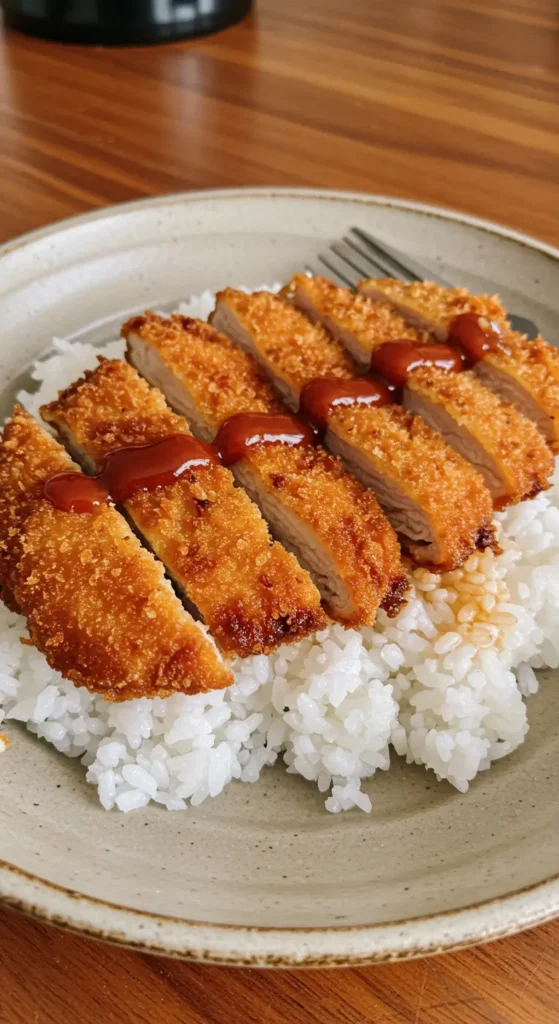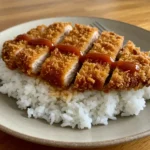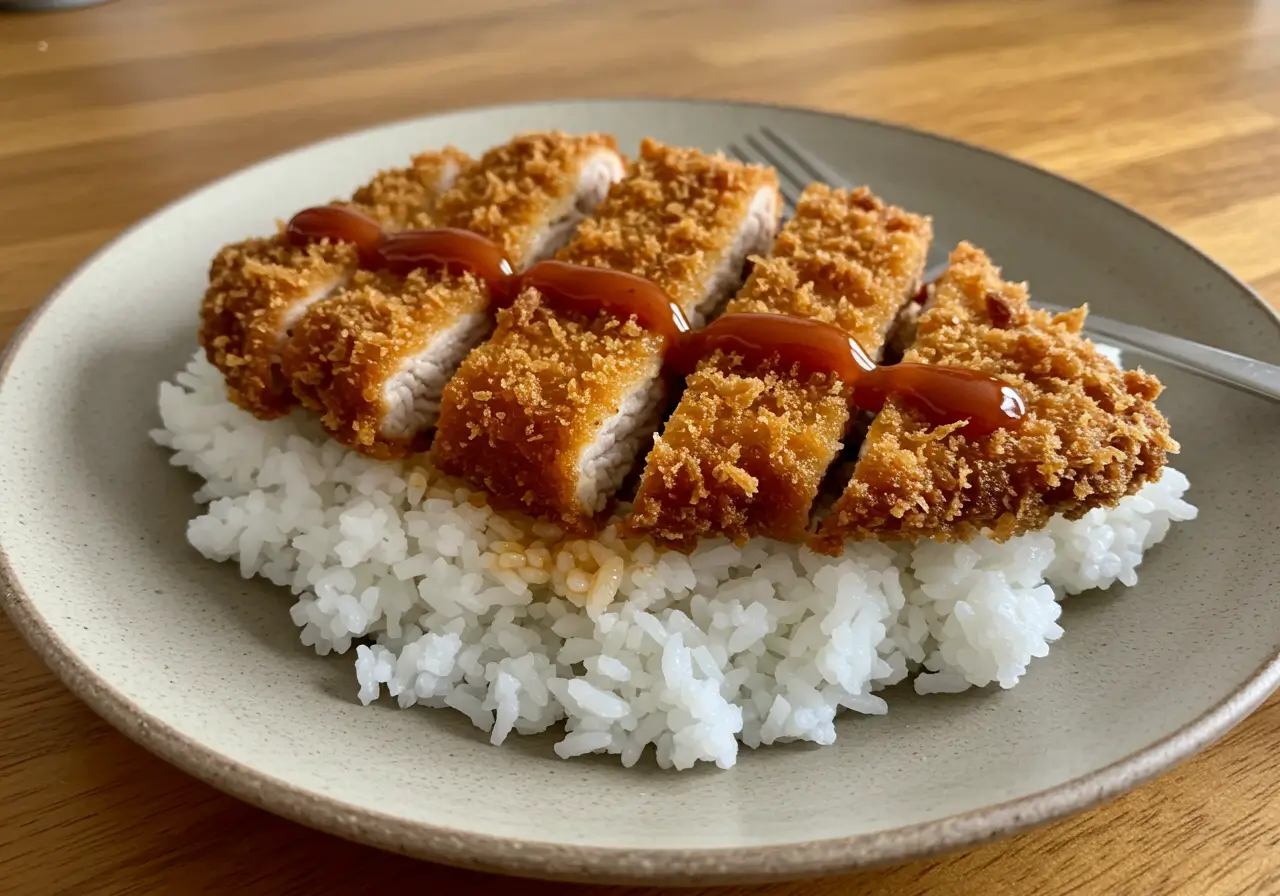Chicken Katsu
Table of Contents
Chicken Katsu isn’t just a meal — it’s a crispy, golden bite of Japanese comfort food that’s made its way into kitchens around the world. In this guide, we’re diving deep into everything you need to know about this crave-worthy dish. Whether you’re a home cook looking to master the perfect crunch or a foodie curious about the history behind that crunchy cutlet, we’ve got you covered.
We’ll start by uncovering the roots of Chicken Katsu, then break down the ingredients, cooking method, tasty sides, and even explore some creative variations. Along the way, you’ll pick up practical tips and kitchen tricks, all while enjoying a fun, relaxed read. Let’s jump right in!
Chicken Katsu Ingredients and Substitutions

Core Ingredients for Authentic Flavor
Making Chicken Katsu at home starts with a few humble ingredients, but oh boy — when they come together, it’s magic. The basics? You’ll need skinless, boneless chicken breast, salt and pepper, all-purpose flour, eggs, panko breadcrumbs, and neutral oil like canola or vegetable.
Each ingredient plays a key role. The flour helps the egg cling to the meat. The egg acts like glue for the panko, which delivers that signature crispy coating. And of course, the chicken is the star — juicy on the inside, golden on the outside.
Oh, and let’s not forget tonkatsu sauce. It’s tangy, sweet, and just a little savory — the perfect dip for your crunchy masterpiece.
Gluten-Free and Healthier Alternatives
Trying to eat a bit cleaner? No worries — Chicken Katsu can still be on the menu. Swap the regular flour for almond or rice flour. Instead of deep frying, go for an air fryer or bake it in the oven with a light oil spray. You’ll still get that tasty crunch without all the grease.
For gluten-free diets, use gluten-free panko or crushed cornflakes. And guess what? You can even try chicken thighs for extra flavor if you’re cool with a little extra richness. With so many options, it’s easy to customize without losing that classic Japanese fried chicken charm.
Step-by-Step Guide to Making Chicken Katsu

How to Properly Prepare and Pound the Chicken
First things first — grab those chicken breasts and give them a good pound. You’ll want them about ½-inch thick. Why? Even thickness means even cooking, which is key to juicy Chicken Katsu every time. Don’t skip this step — it’s what separates dry cutlets from wow-worthy ones.
Sprinkle both sides with salt and pepper. Simple? Yes. But don’t underestimate the power of seasoning.
The Secret to a Perfect Breading Station
Now for the breading — set up your station like a pro. You’ll need three shallow dishes: one with flour, one with a beaten egg, and one filled with panko breadcrumbs.
Dip the seasoned chicken in flour first, tapping off the extra. Then, coat it in the egg. Finally, press it into the panko. Be generous with those breadcrumbs — they’re the secret to that unbeatable crunch. Flip it, press it, and make sure it’s totally covered.
This triple-step method gives Chicken Katsu its golden armor — crispy outside, tender inside.
How to Fry Chicken Katsu to Golden Perfection
Heat up about a cup of oil in a skillet over medium-high heat. You’ll know it’s ready when a breadcrumb sizzles the second it hits the pan. Gently place the cutlets in the oil, cooking for about 3–4 minutes per side until beautifully golden.
Once they’re done, lay them on a paper towel-lined plate to soak up the extra oil. Let them rest a few minutes — it helps the coating stay crisp.
And there you go. With a little care and these easy steps, you’ll master homemade Chicken Katsu that rivals your favorite Japanese restaurant.
What to Serve with Chicken Katsu
Classic Japanese Sides: Rice, Miso, and Pickles
When it comes to serving Chicken Katsu, simplicity wins. Traditionally, it’s plated with a scoop of steamed white rice, a side of shredded cabbage, and maybe a bowl of warm miso soup. These basics aren’t just filler — they balance the rich, crispy chicken with light, clean flavors.
You might also add some Japanese pickles (tsukemono) or even a soft-boiled egg. These little touches add variety and make your meal feel like a restaurant dish right at home.
Modern Twists: Katsu Tacos, Bowls, and Sandwiches
Looking to shake things up? Then you’ve got to try some modern takes on Chicken Katsu. Toss slices into a rice bowl with edamame, avocado, and spicy mayo. Or wrap them into a warm tortilla for a fusion-style katsu taco.
One of the trendiest twists is the Katsu Sando — a Japanese sandwich where crispy chicken is tucked between fluffy milk bread slices, often with a drizzle of tonkatsu sauce. It’s a little fancy, a lot delicious, and super Instagrammable.
Chicken Katsu really is a blank canvas. Whether you keep it traditional or go bold with a new format, you’ll end up with a meal that satisfies every time.
Storing and Reheating Chicken Katsu
How to Store It Safely for Later
Cooked too much Chicken Katsu? (Not a bad problem to have.) Let the cutlets cool to room temp before stashing them in an airtight container. They’ll stay fresh in the fridge for up to three days.
To avoid sogginess, place a paper towel beneath the cutlets to absorb any leftover oil or steam. If you want to freeze them, wrap each piece in plastic wrap and store in a freezer-safe bag — they’ll keep for about a month.
Best Ways to Reheat Without Losing Crunch
Now here’s the tricky part — reheating while keeping that panko crunch intact. Skip the microwave if you can. Instead, reheat the cutlets in an oven at 375°F for about 10–12 minutes, or pop them in an air fryer for 5–7 minutes. Both methods crisp them right back up without drying the meat.
For more delicious recipes, check out our other comfort food articles on Smaczne Gotowanie.
Chicken Katsu Variations
Spicy Chicken Katsu and Sauce Additions
If you love a little heat with your crunch, Spicy Chicken Katsu is calling your name. Start with the same base recipe but add some chili powder or cayenne to the flour for a fiery kick. Want it even bolder? Mix sriracha or gochujang into the egg wash — the spice gets sealed right into the crispy coating.
As for sauces, Chicken Katsu is super versatile. Besides the classic tonkatsu sauce, try creamy Japanese mayo with a dash of soy sauce, or whip up a quick garlic-sesame drizzle. Even a honey mustard glaze can add a tasty twist. The key? Let your taste buds lead the way.
Katsu Curry and Tonkatsu: How They Differ
You’ve probably heard of Katsu Curry — a comforting plate where Chicken Katsu meets a rich, mild Japanese curry sauce. It’s savory, hearty, and oh-so-satisfying. This version is hugely popular in Japan and abroad, especially in bento boxes or cozy restaurants.
Meanwhile, tonkatsu is its pork-based cousin. The method’s nearly identical, but the flavor is richer and a little fattier due to the pork cutlets. So, while they’re both crispy cutlets at heart, the choice comes down to your mood — or your meat.
Chicken Katsu Around the World
How Different Cultures Have Adopted Katsu
From Tokyo to Toronto, Chicken Katsu has found its way into hearts — and kitchens — around the globe. Thanks to its simple ingredients and universal crunch appeal, it’s been embraced by many cultures with open arms.
In Hawaii, for example, it’s a staple in plate lunches, often served with rice and macaroni salad. Meanwhile, in parts of the U.S., you’ll spot it in Asian fusion spots tucked into bao buns, on waffles, or even in tacos.
Katsu in Hawaii, Korea, and Beyond
Koreans have their own spin, too — think ultra-crispy katsu served with kimchi or spicy pickles. And in Australia and the UK, it’s not unusual to see Chicken Katsu curry as a popular takeaway dish.
Each version keeps the soul of the dish intact — that crisp, juicy cutlet — while adding a local twist. So no matter where you bite into it, Chicken Katsu always brings the comfort.
Print
Chicken Katsu
- Total Time: PT25M
- Yield: Serves 4
- Diet: Halal
Description
This crispy Chicken Katsu recipe brings the iconic Japanese comfort food to your kitchen. Juicy chicken breast is coated in light panko breadcrumbs and fried to golden perfection. Served with rice, tonkatsu sauce, and optional sides like miso soup or cabbage, it’s a delicious and easy meal you can make at home.
Ingredients
- 4 skinless, boneless chicken breast halves (pounded to ½-inch thickness)
- Salt and pepper to taste
- 2 tablespoons all-purpose flour
- 1 egg, beaten
- 1 cup panko breadcrumbs
- 1 cup oil for frying (canola or vegetable oil)
- Optional: Tonkatsu sauce for serving
Instructions
- Pound the chicken breasts to an even ½-inch thickness and season with salt and pepper.
- Prepare three shallow dishes: one with flour, one with beaten egg, and one with panko breadcrumbs.
- Dredge each chicken breast in flour, dip into the egg, and coat with panko breadcrumbs, pressing gently to adhere.
- Heat oil in a skillet over medium-high heat. Fry chicken for 3–4 minutes per side until golden brown and cooked through.
- Transfer the chicken to a paper towel-lined plate and let rest for 2–3 minutes.
- Slice and serve hot with rice and tonkatsu sauce.
Notes
- For a lighter version, try baking or air frying the chicken katsu.
- Gluten-free panko and flour can be used as substitutes.
- Great for bento lunches or sandwiches.
- Prep Time: PT15M
- Cook Time: PT10M
- Category: Dinner
- Method: Frying
- Cuisine: Japanese
Nutrition
- Serving Size: 1 cutlet
- Calories: 297
- Sugar: 0g
- Sodium: 251mg
- Fat: 11g
- Saturated Fat: 2g
- Unsaturated Fat: 8g
- Trans Fat: 0g
- Carbohydrates: 22g
- Fiber: 0g
- Protein: 31g
- Cholesterol: 118mg
Keywords: Chicken Katsu, crispy chicken cutlet, panko chicken, Japanese fried chicken, tonkatsu, katsu curry, homemade Chicken Katsu
Chicken Katsu FAQs
What’s the difference between Chicken Katsu and Tonkatsu?
Great question! While both dishes use the same breading and frying technique, Chicken Katsu is made with chicken breast, while tonkatsu uses pork cutlets. Chicken tends to be lighter and leaner, while pork gives you a richer, slightly fattier flavor.
Can you bake Chicken Katsu instead of frying it?
Absolutely! To make baked Chicken Katsu, simply prep the cutlets as usual, then bake them on a wire rack at 400°F for about 25 minutes. Flip halfway through for even browning. You’ll lose a bit of the oil-fried crunch, but it’s still golden and delicious.
What sauce goes best with Chicken Katsu?
Tonkatsu sauce is the go-to — it’s tangy, savory, and slightly sweet. You can also mix ketchup, soy sauce, and Worcestershire if you want a quick homemade version.
Is Chicken Katsu healthy?
It depends on how it’s cooked. Fried versions are higher in calories, while baked or air-fried Chicken Katsu can be a lighter alternative. Pair it with veggies and go easy on the sauce to keep things balanced.
What does “katsu” mean in Japanese?
“Katsu” is short for “katsuretsu,” which means cutlet in Japanese. It’s a beloved comfort food across Japan, found everywhere from family dinners to bento boxes.

